With the advancement of modern research in traditional Chinese medicine (TCM), evidence regarding the clinical efficacy and mechanisms of action of TCM has rapidly accumulated. However, due to a lack of methodological safeguards, the disconnection between clinical and basic research in TCM has become increasingly prominent, making it difficult to form an evidence chain that supports the scientific value of TCM in a manner that is "clear and understandable". Therefore, it is necessary to develop methods for the translation and integration of clinical and basic research evidence oriented towards clinical value, to form a reliable evidence chain that can further discover patterns, confirm efficacy, and highlight advantages. This article discusses the construction and evaluation methods of the evidence chain for the efficacy of TCM, aiming to provide theoretical and methodological references for related work.
Citation: ZHANG Junhua, PANG Wentai, YANG Fengwen, CAO Lujia, JI Zhaochen, ZHANG Boli. Construction and evaluation of the evidence chain for the efficacy of traditional Chinese medicine. Chinese Journal of Evidence-Based Medicine, 2025, 25(4): 479-484. doi: 10.7507/1672-2531.202412121 Copy
Copyright © the editorial department of Chinese Journal of Evidence-Based Medicine of West China Medical Publisher. All rights reserved




